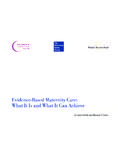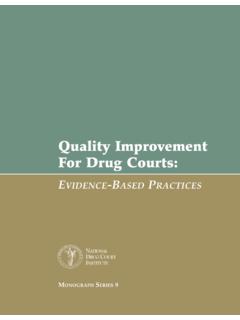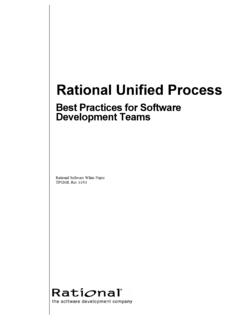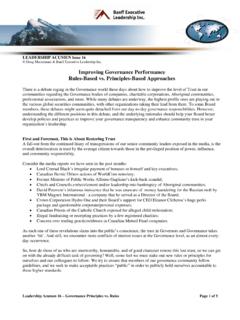Transcription of Mentoring the Staff Nurse in Evidence Based Practice and ...
1 1 Mentoring the Staff Nurse in Evidence Based Practice and Conduct of ResearchMentoring the Staff Nurse in Evidence Based Practice and Conduct of ResearchKathleen M. Vollman MSN, RN, CCNS, FCCM, FAANC linical Nurse Specialist/Educator/ConsultantADVANCING NURSING Northville, ADVANCING NURSING LLC 2015 ResearchResearch I could never do that I don t know how I would ever get started Boring The process seems so frightening & overwhelming I really don t understand it or know enough about it to be able to do research 2 University Outcome:Limited knowledge in evaluation of research, how to utilize it or conduct researchUniversity Outcome:Limited knowledge in evaluation of research, how to utilize it or conduct research Because we always do it that way 3 Research Utilization Activities Assessment parameters are established.
2 Preventative actions are identified Interventions are evaluated in the clinical setting to determine the effect on patient care and the reasoning by which:CLINICALPRACTICECLINICALPRACTICENU RSINGRESEARCHNURSINGRESEARCH4 Problems with Some Hospital Based Clinical Research Programs A traditional academic model of research is used Full and active administrative commitment is not achieved Research is not integrated into the organizational infrastructure and is not aligned with goals Often focus on the needs of the researcher versus the needs of the patientCampbell GM, 2007 Evidence - Based Practice MODEL5 evidenced - Based PracticeThe conscientious, explicit, and judicious integration of the best available Evidence from systematic research, with individual clinical expertise and patient preferenceat the bedside in making decisions about clinical is Evidence ?
3 That which tends to prove or disprove something Ground for belief Something that furnishes proof( , 2010) Types: External generated from rigorous research Internal generated from outcomes management; Practice Based evidence6 Evidence Based Nursing Asking a clinical question Searching the literature for relevant research Critically appraising what has been found If change is warranted by the research Evidence and if it fits with clinician skills, resource availability, and patient preferences, then the following stages also take place: Implementing the change in Practice Evaluating the change in practiceResearch- Evidence To Describe To Explain To Predict To Explore To Discover What if we did it this way?That is not the way we do it here?
4 Why that not this way?7 WHAT S THE DIFFERENCE:QI, EBP, & RESEARCH? Quality The degree of excellence Evidence - Based Practice Integration of best Practice research with clinical expertise & patient s unique preferences and values Research Systematic inquiry using disciplined methodsAssessing Readiness for EBP Descriptive cross-section survey 120 nurses in midsize care hospital in the Midwest 64 item readiness survey tool Results of individuals consulted colleagues when they needed information rather than books or journals 24% access databases Perceived EBP knowledge to be moderate The culture for EBP stronger on the unit then in the organizationThiel L, et al. Worldviews on Evidence - Based Nursing 2008;5(4):182-1928RN: Application of the Evidence Cross-sectional design Six item survey self reported EBP 987 RNs two years postgraduate (76% return rate) Results; 19% formed questions and perform searches 56% used information from other information sources 31% appraise the literature 30% participated in Practice development 34% participated in evaluating clinical Practice RNs working in eldercare apply Evidence - Based Practice more than those in acute care Contextual factors in the role of the in the organization impacted utilization of EBPB ostrom Am, et al.
5 J of Eval in Clin Practice , 2009;15:1159-1163 WHY Evidence - Based Practice ?Everyone Must Bring Data!& a StoryMelnyk, EBP: Making it Work in Your Organization Webinar 3/20109 WHY Evidence - Based Practice ?Outcome Based on Practice0%5%10%15%20%25%30%35%40%Traditi onal PracticeEvidence- Based Practiceoutcom eHeater, Becker, & Olson, 198828% ImprovementWHY Evidence - Based Practice ? Crossing the Quality ChasmCommittee on Quality Health Care in America,Institute of Medicine, 2001 Rule # 5: Evidence - Based decision-making 90% Healthcare decisionswill be evidenced basedby 2020 (IOM Roundtable on EBP)10 WHY Evidence - Based Practice ? 21% of 1200 practicing nurses implemented Evidence from research into their Practice (Bostrom & Suter, 1993) Healthcare providers not following Evidence Based guidelines 1/3 of the time (Cretin, Farley, Dolter & Nicholas, 2001) 10-15% consistently implementing EBP(Melnyk, 2010) Takes 17 years to translate findings into Practice (Balas & Boren, 2000)WHY Evidence - Based Practice ?
6 Healthcare providers have higher levels of satisfaction using EBP (Dawes, 1996) Quality safe care delivery while reducing cost and turnover rates (Titler, Cullen & Ardery, 2002) Without Evidence , Practice is rapidly outdated: 30-40% receive outdated Practice Infant prone positioning (AAP, 2000) Beta blockers in acute myocardial infarction (Slutsky, 2003)11 WHY Evidence - Based Practice ? Best service possible Up to date knowledge Supplements clinical judgment Saves time Improves care Saves livesEBP Leads to: Improved patient outcomes Avoidance of unnecessary procedures Reduction of complicationsNurses should feel empowered to change Practice using proven methods12 Evidence Based Interventions Skin risk assessment in predicting patients likely to breakdown Braden Skin Risk Assessment Oral care antisepsis & brushing the teeth for reducing the incidence of healthcare acquired pneumonia Best time of day to weigh a patient?
7 Mobilization of patients reduces the risk of de-conditioning and long term complications of functional limitationswww, ; Macklebust,JA (2009) The Braden Scale reliable assessment to effective interventionsMorris PE, et al. Crit Care Med, 2008;36:2238-2243 Pohlman MC, et al. Crit Care Med, 2010;38:2089-2094 Schweickert WD, et al. Lancet, 373(9678) B. et al. J Advocate Health 2002;4(1):27-30 BARRIERS TO EBP Lack of knowledge and skills Low comfort level with search techniques Perceived lack of time Challenges with critically appraising research Lack of organizational/administrative support Educational programs that continue to teach research the traditional way with a focus on producing instead of using Evidence Negative attitudes toward researchMelnyk, EBP in Nursing & Healthcare, 2011, Lippincott Williams & Wilkins13 Challenges - Cook Book Practice Threatens the art of patient care.
8 Clinical Knowledge vsClinical Wisdom Evidence can inform but cannot replace clinical judgment. Best Evidence shouldbe integrated with clinical expertise and Requires the best Evidence to answer the question. The question determines the best Evidence . RCT is the gold standard if the question is about whether an intervention is more effective than on Randomized Control Trials (RCT) and Systematic Reviews 14 Facilitators & BarriersPatterson-Kelly K, et al. J of Nurs Adm, 2012;43:18-23 The Basis for Nursing Care U. S. Nurses Working in Clinical Practice : 54% were not familiar with term EBP 82% never used a hospital library 67% get information for Practice from other nursesPravikoff DS, Pierce ST, Tanner A.
9 Nurs Outlook. Jan-Feb 2005;53(1) Do We Get Information to Leap From the Pages of Magazines and Into Our Heads and Become Part of Our New Daily Routine?16 Starting the JourneyOrganizational Assessment: 50,000 Feet What does the organization have in place to promote nursing research and Evidence - Based Practice Has a model been adopted? Are there APRN s or others to facilitate the process? Is there access to statistical software, publishing software and editorial assistance? Is there a nursing council structure to help guide and educate through the IRB process?17 Iowa Model Successfully implemented since 1994 internationally Infuses research into Practice to improve quality of care Planned change principles integrate research and Practice Utilizes a multidisciplinary team approach Utilizes feed-back loops18 Focus of the Model Academic Theory building & testing Broad scope Findings not immediately applicable Service Setting Clinical focus Narrow scope Finding more usable to the frontline practitionerEvidence Based PracticeShared Governance19 Nursing Department Benefits from a Clinical Research Program Significant number of completed and ongoing projects Multiple opportunities for Staff to give presentations, posters etc.
10 Magnet Visibility and ImageCampbell G, 2007 Key Component For a Successful Journey20 Components of Creating a Research Friendly ClimateComponents of Creating a Research Friendly Climate Mentoring Increase comfort level in reading research Always question practices and actions within your environment Integration into the infrastructureCultivate a Spirit of Inquiry & EBP Culture Set EBP as an institutional expectation and build it into the vision, mission and strategic plan of the organization Staff evaluations Competencies Clinical ladder Incorporate EBP guidelines and Practice changes into policies and proceduresMelnyk, BM., Fineout-Overholt E. EBP in Nursing & Healthcare, a Spirit of Inquiry & EBP Culture Include EBP as part of every new clinician s orientation Provide ongoing continuing education on EBP Disseminate results of EBP implementation Provide library and internet resources Develop EBP mentors to work regularly with clinicians at point of careMelnyk, BM.








